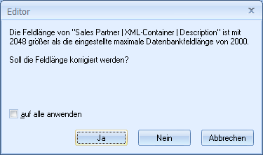Validating an Object Definition
Before you let users access the object definition you should first validate it. Inconsistencies may occur within the object definitions, especially by copying and importing data.
The validation of the object definition checks the following points:
- Maximum database field length
Checks if the maximum database field length for text fields, such as those found in the default settings, has been exceeded by dialog elements.
- Minimum and maximum form size
Checks if the minimum or maximum form size for objects has been exceeded.
- Catalog syntax
Checks if the syntax of the catalog entries is correct.
- Cross-references between catalogs
Checks if the specified catalog exists in the catalog references.
- The property 'Controlled by crosscheck'
The system checks whether the dialog element to which the link refers exists for cross-references between dialog elements using the 'Controlled by crosscheck' property.
If an inconsistency is detected this will be displayed in a message.

You can choose to let the entry be corrected, to let all similar entries of this type be corrected, to not let the entry be corrected, to not let all similar invalid entries of this type be corrected, or to cancel validation.
Validation is started by clicking Validate object definition in the File menu. The current editing status of the active object definition will be validated.
If you let the object definition be changed by validation, you will need to save and then reload the engines so that the changes are available to the user the next time enaio® client is started.
If you allow the database field length to be edited you will need to update the corresponding tables afterwards.
Validation also opens the performance wizard.
Validation does not check if the internal name contains special characters which are not valid in the active version.
This active validation is only available to users with appropriate rights. Users with limited rights, e.g., who can only edit catalogs, can perform a passive validation. The results are displayed in the output area. If a log file was specified on the Output logging tab, this log file is also created.
 areas. Use the toolbar to show all hidden areas at once:
areas. Use the toolbar to show all hidden areas at once:
